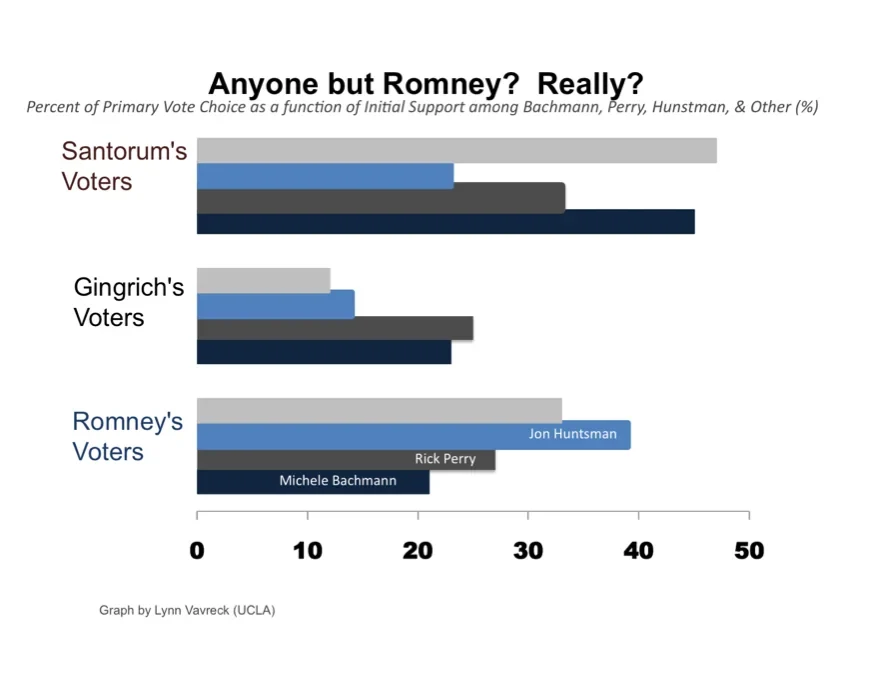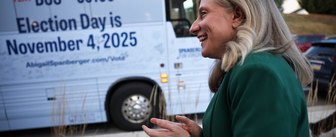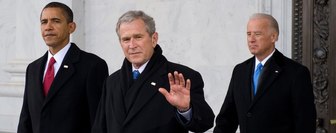Back in January, many people wondered whether Mitt Romney’s support in the Republican primary (about 25%) was a floor or a ceiling. The question was whether that quarter of the Republican electorate was made up of solid supporters who would be a foundation from which Romney’s support could grow or whether they were the only Republican primary voters who would vote for Romney. Through our relationship with Model Politics, John Sides (George Washington University) and I have been asking 1,000 people a week to tell us about their political choices. We now have 11 weeks of data about Romney, his challengers, and how voters choose among them.
These data provide a great snapshot of the GOP electorate at any point in time, but more importantly, YouGov, which fields the Model Politics surveys, did a large political profile of all the people who answer their polls in December of 2011, right before the nomination process officially started --- and wait for it – everyone who has been interviewed in one of the weeks in 2012 was also interviewed in December of 2011. This means that we have repeated data on each respondent in our weekly surveys, which means we can track changes over time.
What do we learn from these changes over time? As you will see, there is very little evidence to suggest a strong “anyone but Romney” trend, but there does seem to be a small set of Republican primary voters holding out on switching to Romney. More interestingly perhaps, this pattern is not unusual. Simon Jackman (Stanford) and I found a similar phenomenon when we analyzed the Hillary Clinton-Barack Obama contest in 2008.
The first number worth reporting is from these data is 40%. That is the percentage of likely Republican primary voters who have changed their minds at least once between December 2011 and when they were interviewed. This has a bit to do with how many candidates have dropped out of the race. With the exits of Michele Bachmann, Rick Perry, and Herman Cain, some voters are forced to change their minds and move to another candidate. When we take away these “forced” movers and recalculate the rate of change, we find about 28% of Republican primary voters changed their minds at least once (among people whose initial preference in still in the race). And if we isolate change further looking only among voters whose initial preference was either Newt Gingrich or Rick Santorum, we find about a third (32%) changed their minds at least once to date. The comparable number for initial Romney voters is 24%.
A good deal of the changes in preferences come from people switching among candidates still in the race and not only from supporters of those candidates who have dropped out. And perhaps more interestingly for the “anybody but Romney” narrative is the fact that more initial Gingrich and Santorum voters switch than initial Romney supporters – and Romney is picking up some of those switchers.
You can examine the rate of switching for each candidate among all likely GOP voters in the first column of the table below; and their rates of gains from
| Initial supporters who left | Current supporters who came from another candidate | |
|---|---|---|
Romney | 24% | 31% |
Gingrich | 34% | 36% |
Santorum | 29% | 50% |
Paul | 24% | 27% |
Data are from YouGov weekly polls starting in January 2012 and going through March 9th. Initial support is measured in a YouGov profile survey in December of 2011 | ||
It is easy to see that Santorum has been a draw for switchers. Half of his current support is made up of voters who have switched to him after initially preferring someone else. The fact that Santorum’s initial base of support was so low in December is not irrelevant in calculating this number, but it should not take away from the important pattern: people are moving toward him. His pattern of draw resembles what political scientists call momentum.
But Romney’s numbers are telling, too. Of his current composition of supporters, a third of them have switched from other candidates. Among voters who have changed their minds, 28% have ended up with Romney and 37% with Santorum (Gingrich gets 24% and Paul 11%). But where have these voters come from? Is Romney picking up anyone of set of people we would think of as “anybody but Romney” voters?
In the figure below I present the distribution of initial Bachmann, Perry, Huntsman, and Cain (and other) voters. One thing is clear from the figure: Romney picked up a good deal of support from Bachmann’s voters, almost a third of Perry’s supporters, nearly half of Huntsman’s voters, and a quarter of Cain voters. Romney’s support is made up of some voters who preferred one of the more socially conservative candidates at one point in time. Some of these voters will vote for Mitt Romney.
The question is, will any of the people voting for Gingrich now switch to Romney if Gingrich leaves the race? When we examine a head-to-head choice between Romney and Santorum for voters who currently prefer Gingrich and even split emerges. Forty-nine percent of Gingrich voters choose Romney in a direct choice between Romney and Santorum. Fifty-one percent choose Santorum.
There is a set of voters in this nominating contest who seem unwilling to vote for Romney, but there are plenty of voters who will vote for him – even if they have preferred one of the more socially conservative candidates previously.
It would be wrong to believe that all or even most of Gingrich’s support would flow to Santorum if Gingrich left the race.









